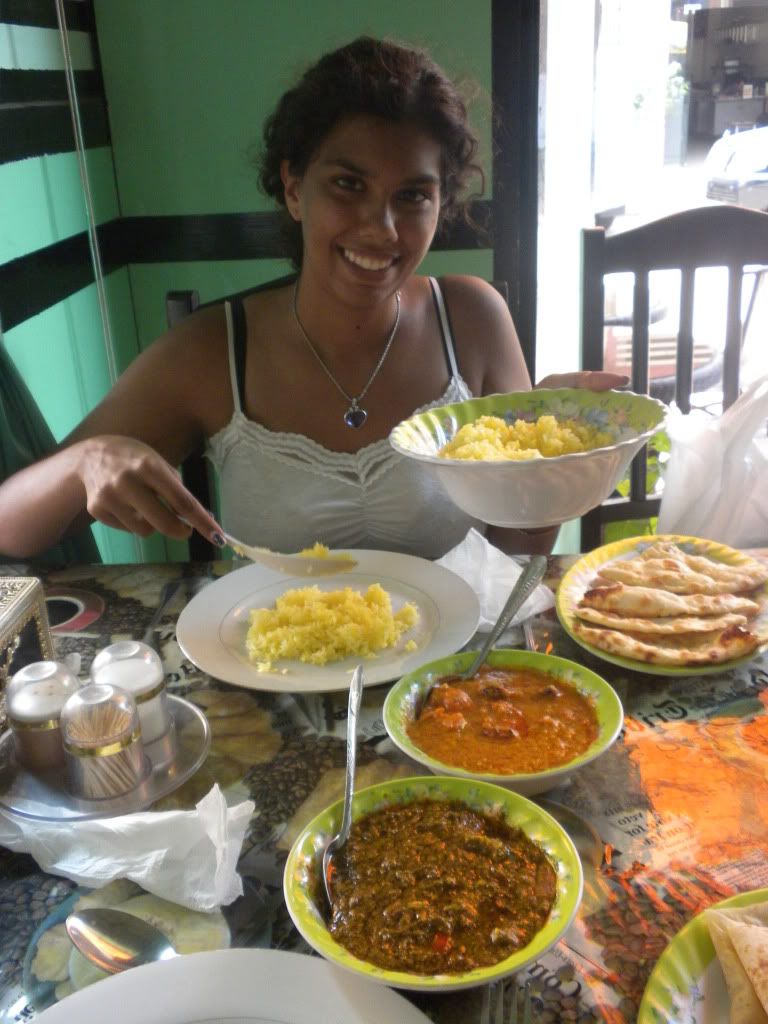Francesca and Henk-Jan's Backpacking Trip!
Saturday, April 3, 2010
Dancing Around Cambodia
The guide first took me to the wax museum where I learned something interesting: Cambodian’s first ruler had been a woman! Her name was Lieou-Ye and she ruled Funan in the 1st century. For some reason I couldn’t find much information on her so if you find anything let me know! Most of the other wax figures were former Kings, Queens, and leaders, along with movie and music stars.
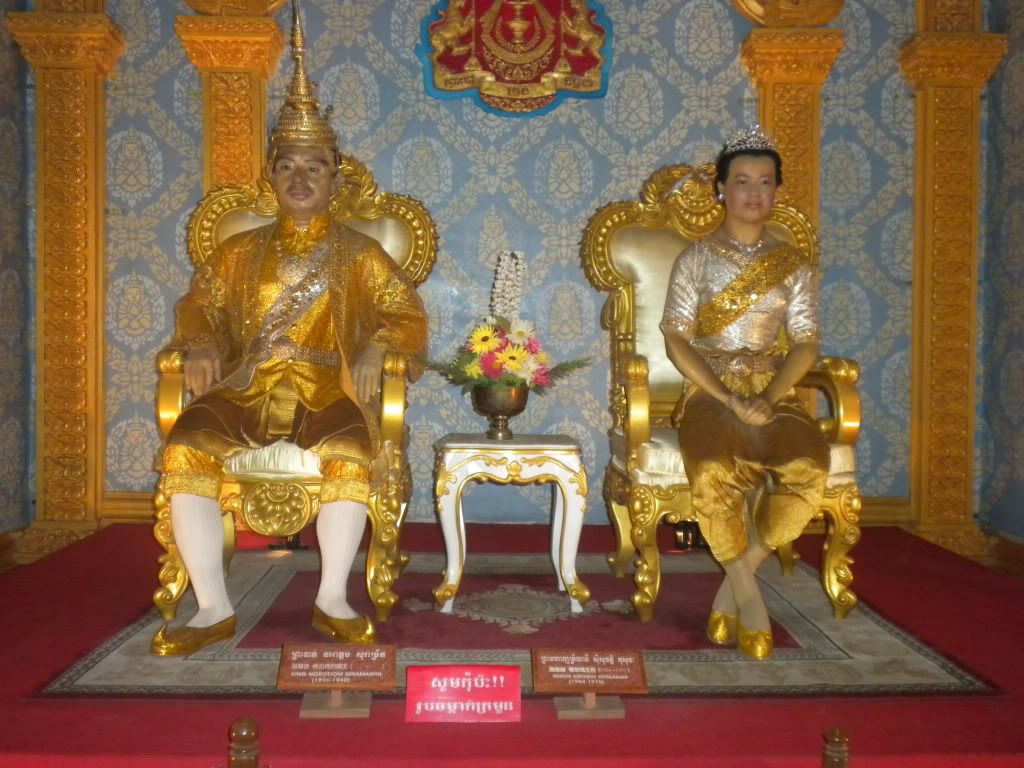
They even had examples of some of the minority groups of Cambodia, the Phnorng and the Kroeung, whose dances I would see later in the day. There was no one I could instantly recognize besides the famous Apsara dancer wax sculpture. Those you can’t miss! Oh! I was also shown a painting of the scene carved on the walls of Angkor: the Khmer fighting the Cham complete with various weapons and elephants. Cool to see a reproduction in color of the classic!
The Phnorng:
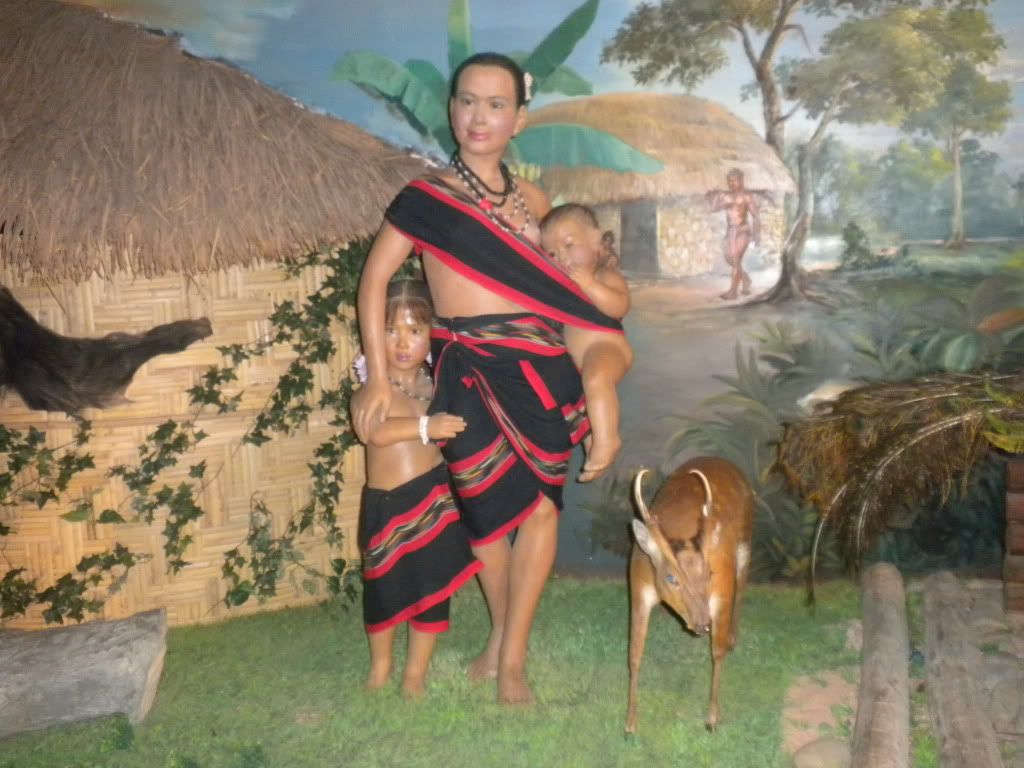
The Kroeung:
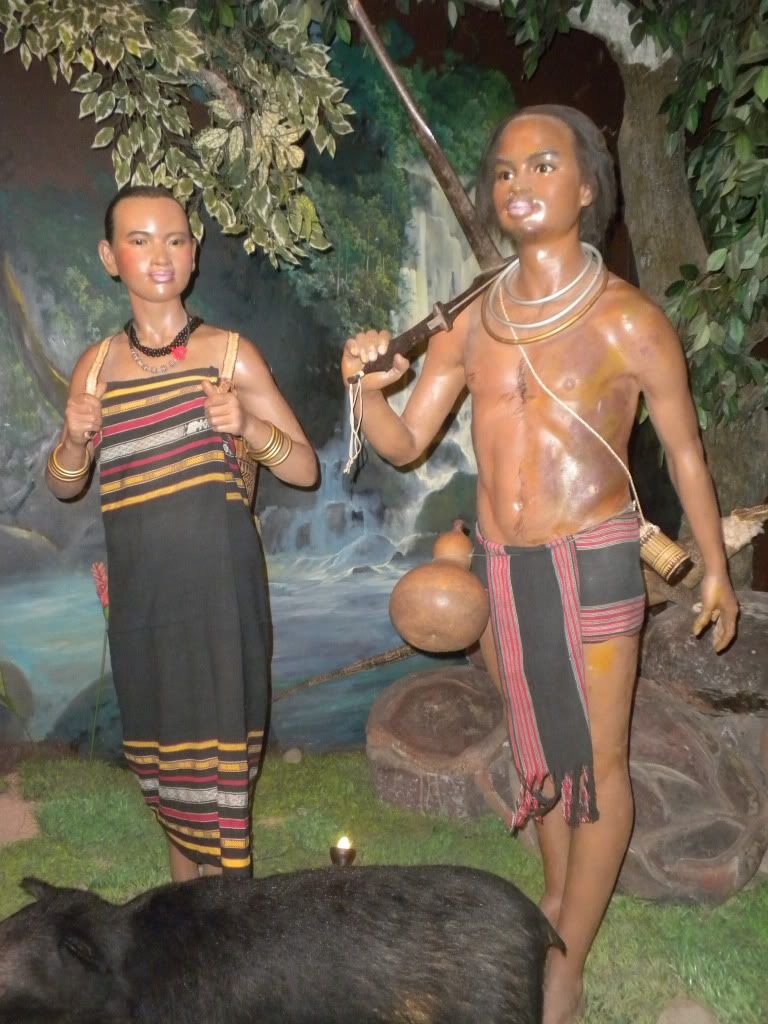
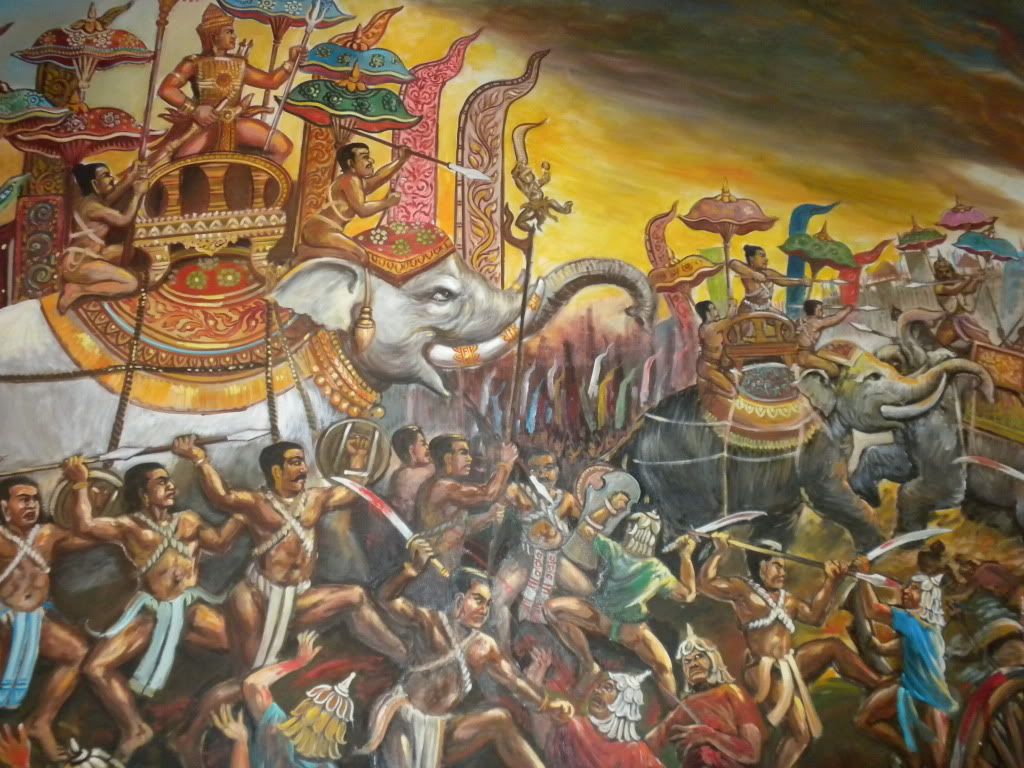
Next I was led through the miniature buildings. Since we were going to see the large scale versions quite soon in Phnom Penh I didn’t trouble too much with looking at these. The only thing really to note is that later that night when it was dark outside I realized the miniatures were completely covered in Christmas lights! Looked pretty awesome but my camera had died by then so no pictures could be taken!
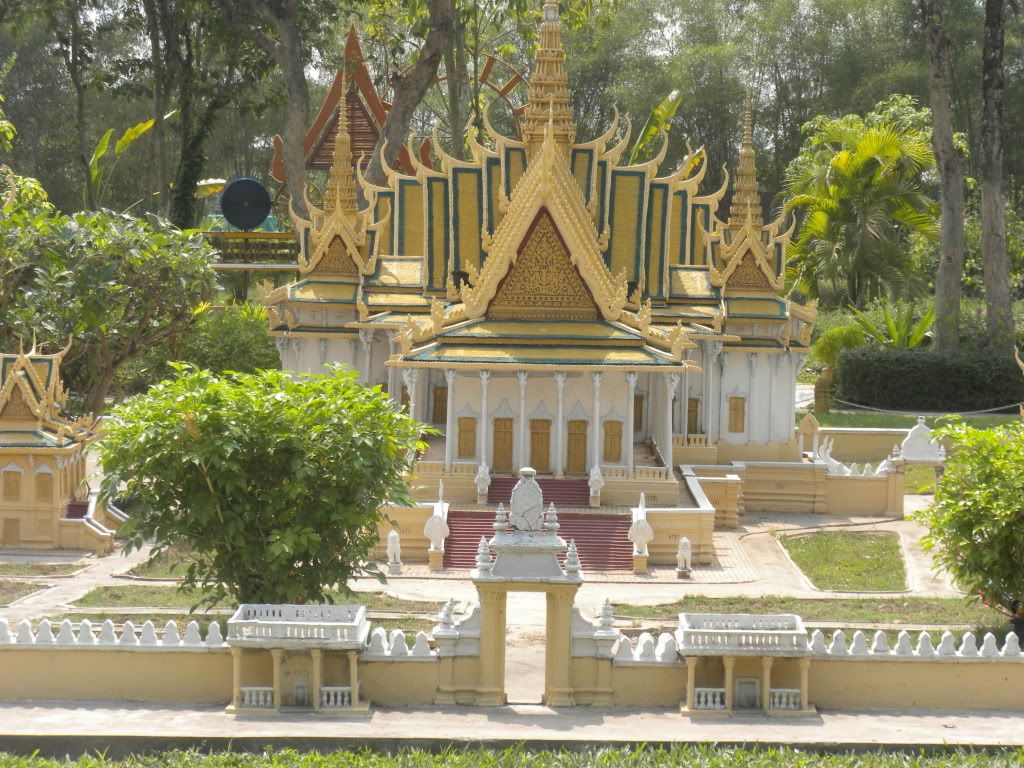
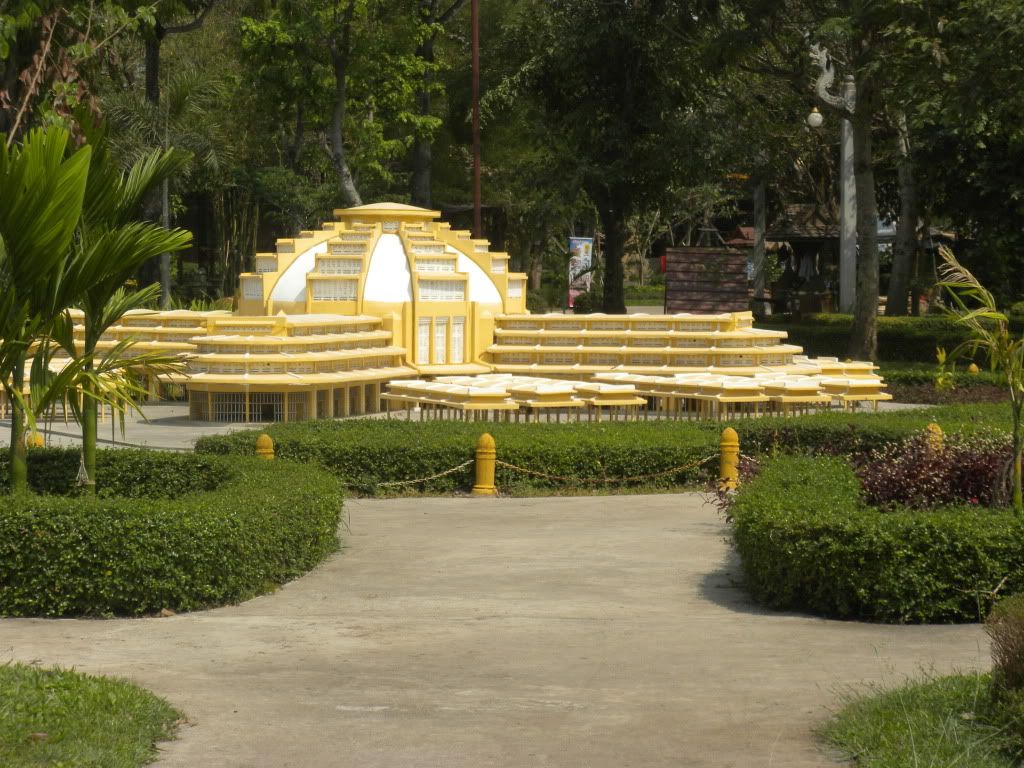
By 2:30 PM it was time for the first dance. The guide and I made our way to the miniature theater for the “Charming of Phahum” which, he explained, was basically a Cambodian love story. The parents of the girl want to marry her off to a rich guy, but the girl is already in love with a poor one. Throughout the story the rich guy and poor guy have their posses fighting it out, which made for some surprisingly good choreography. See for yourself from my pictures:
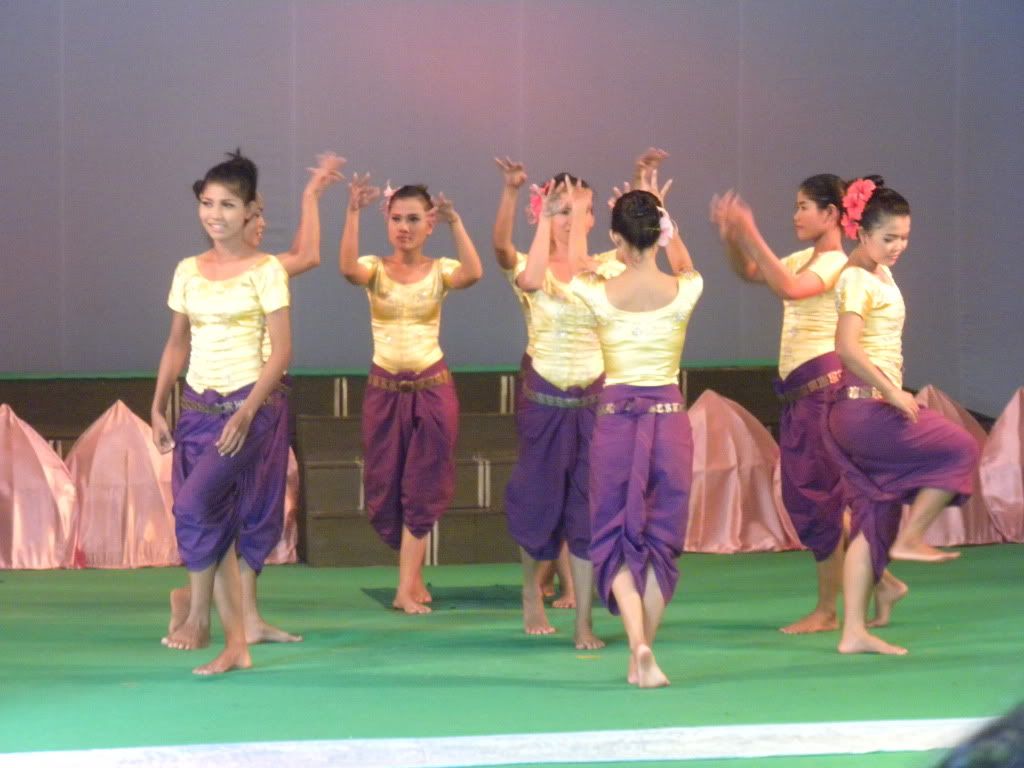
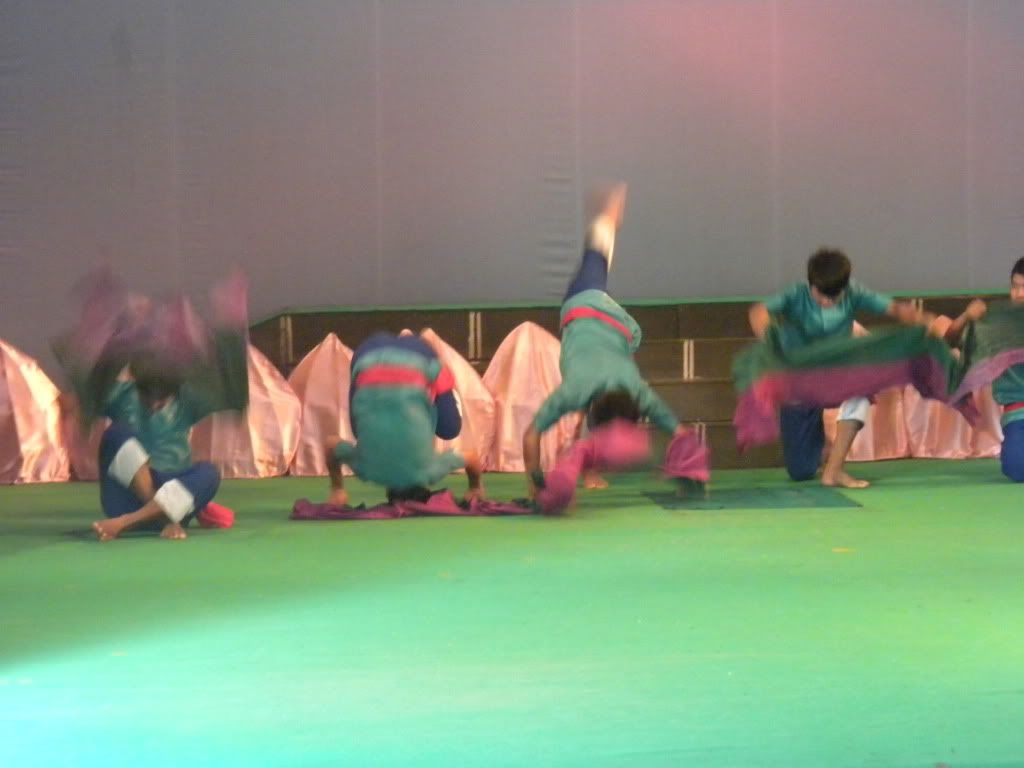
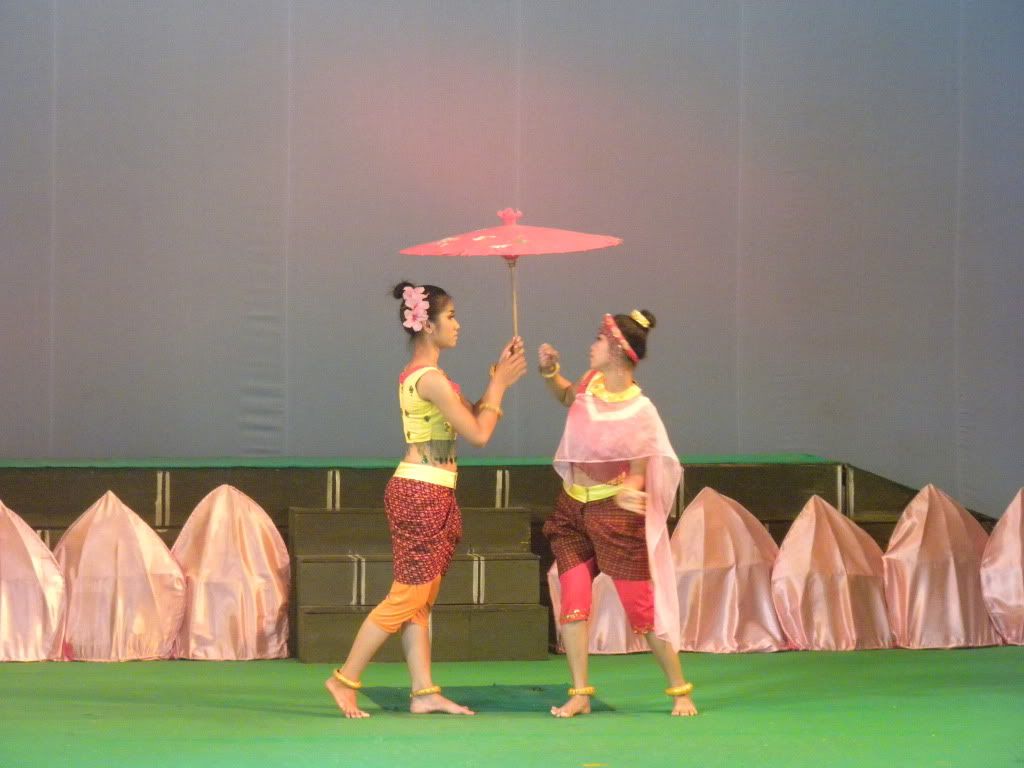
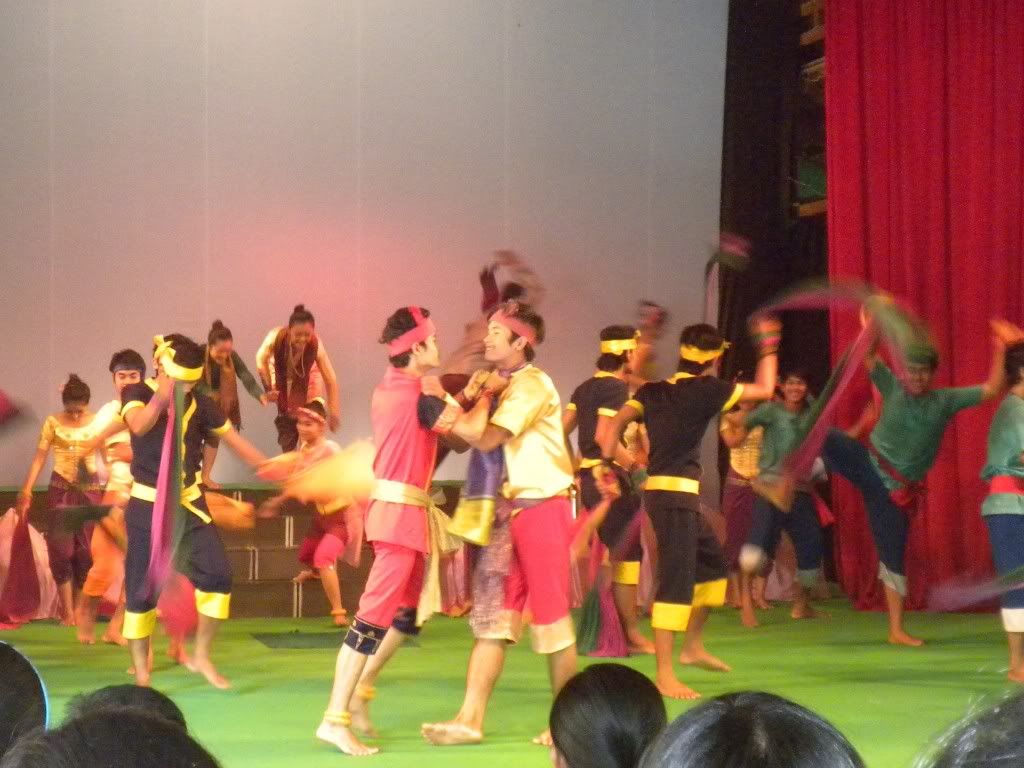
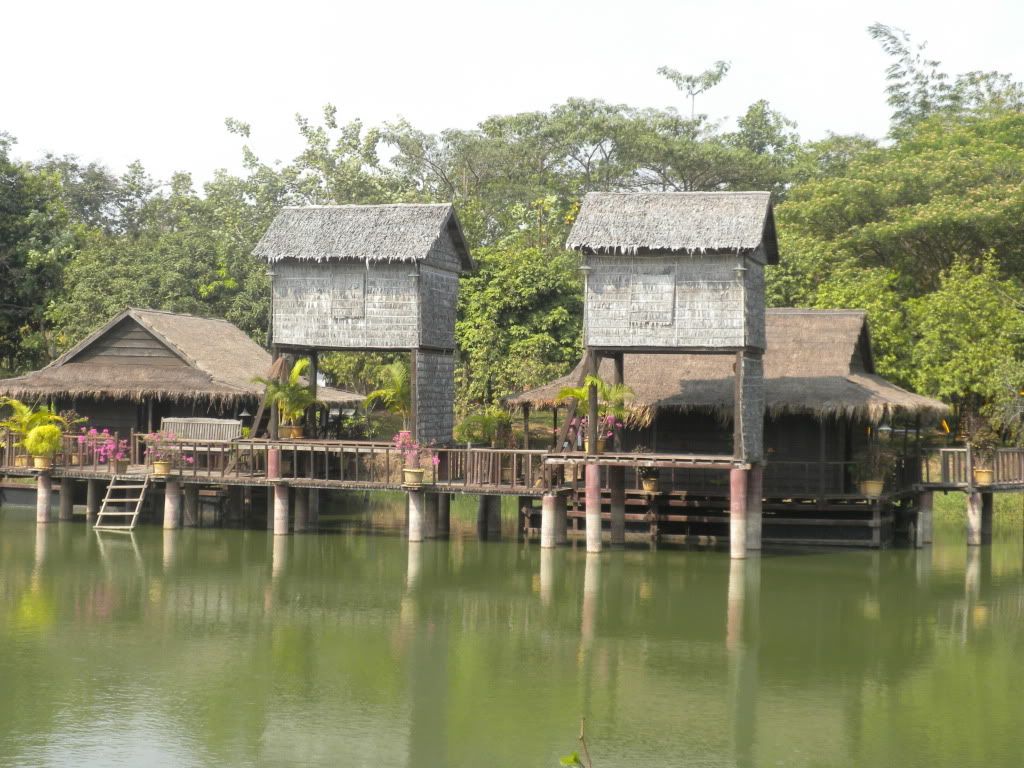
Next we went for the performance I had most been looking forward to: the Khmer Wedding Celebration. This dance was held at the ‘Millionaire House,’ the example of a rich Cambodian’s house. To my delight I found that the bridge and groom were dressed in sparkly purple outfits! (The Khmer typically have very colorful weddings, with the bride changing multiple times into different colored outfits throughout the 3 day ceremony. Everyone else also dresses in festive colors. I even read this online at the Khmer Institute website: “If the wedding were a week-long affair, she could declare the color of her dress each day and the guests would dress only in that color.”)
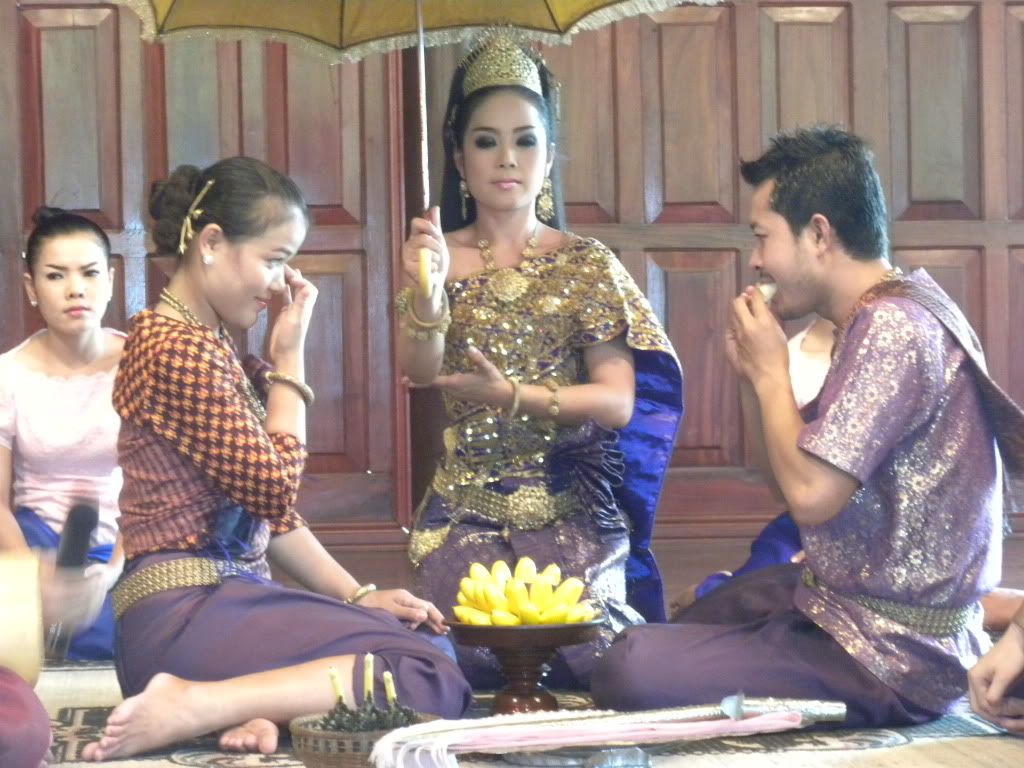

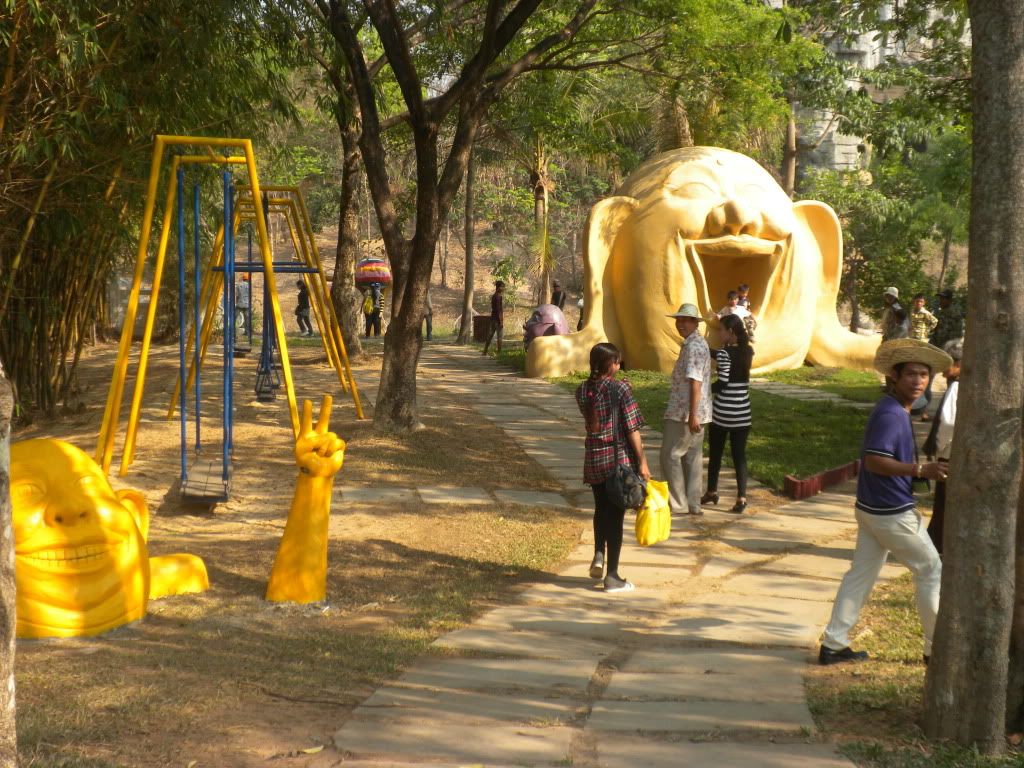
First thing that struck me as odd was the presence of a bowl of bananas. I watched as they performed a ritual with the bananas which are ceremoniously fed during the Wedding. Bananas are known as “Chek” in Cambodia and are very popular, even saved some people’s lives during the scarce-food time of Pol Pot’s regime. Cambodia Leisure’s website states: “On the day of a wedding, Cambodians bring the couple two fruit-bearing banana trees pulled from the base of the stem. The fruit of one plant in sprayed gold while the other is painted silver. When they are dry, the plants are placed in front of the wedding pavilion. "We spray gold and silver colors on the banana fruit in order to bring wealth and good luck for the new couple," said (A Char) Monireth, a priest. "Our country is an agriculture country and Chek is one [product] that represents agriculture and wealth. Chek can grow easily, so the people think that the new couple's love and future will grow like Chek.”
There was also a display of Chinese acrobatics at the Chinese Village – people jumped through hoops, made towers out of their bodies, and interacted with short comedy routines. After the Chinese dancing we moved on to the Kola Village to check out their Peacock Dance, passing by a Cham building on the way where I took one look at the architecture and realized they must be Muslim! The Kola people are a Cambodian minority group who came to west Cambodia in the 1870’s-- many believe they are originally from Burma. They make their living by mining for gem stones and crafting them. In fact, it is thought they are the same people as the Shan we encountered back in Thailand! This makes sense, because during our hilltribe show in Thailand we also witnessed the famed peacock dance as well. Looks pretty familiar…

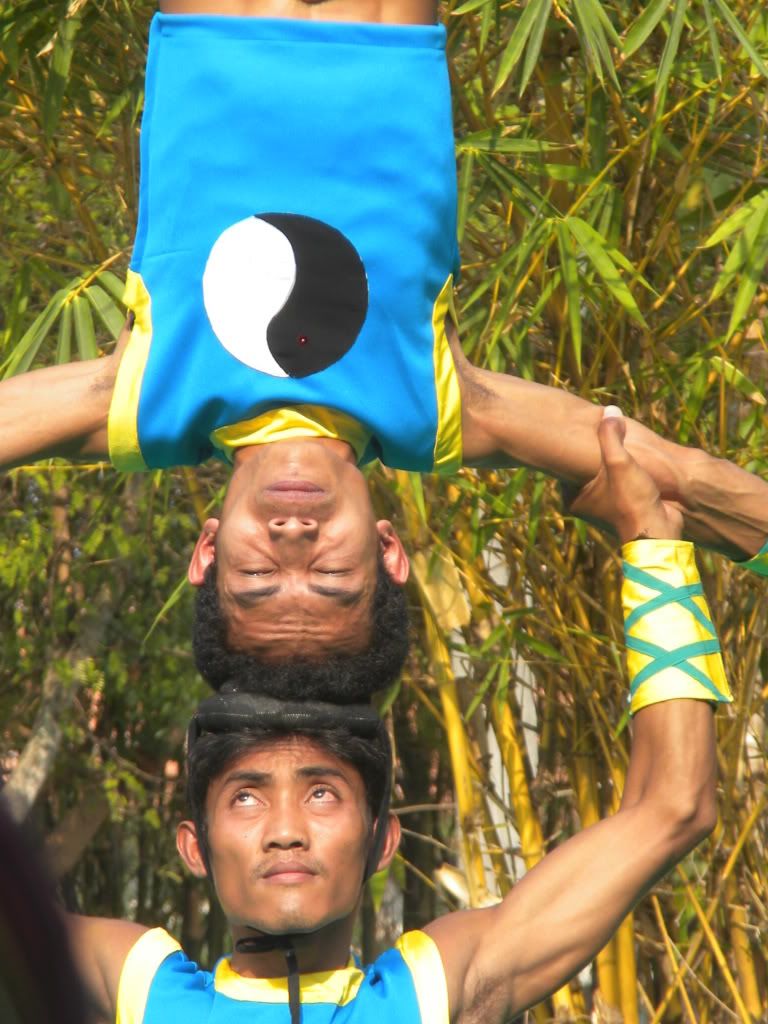
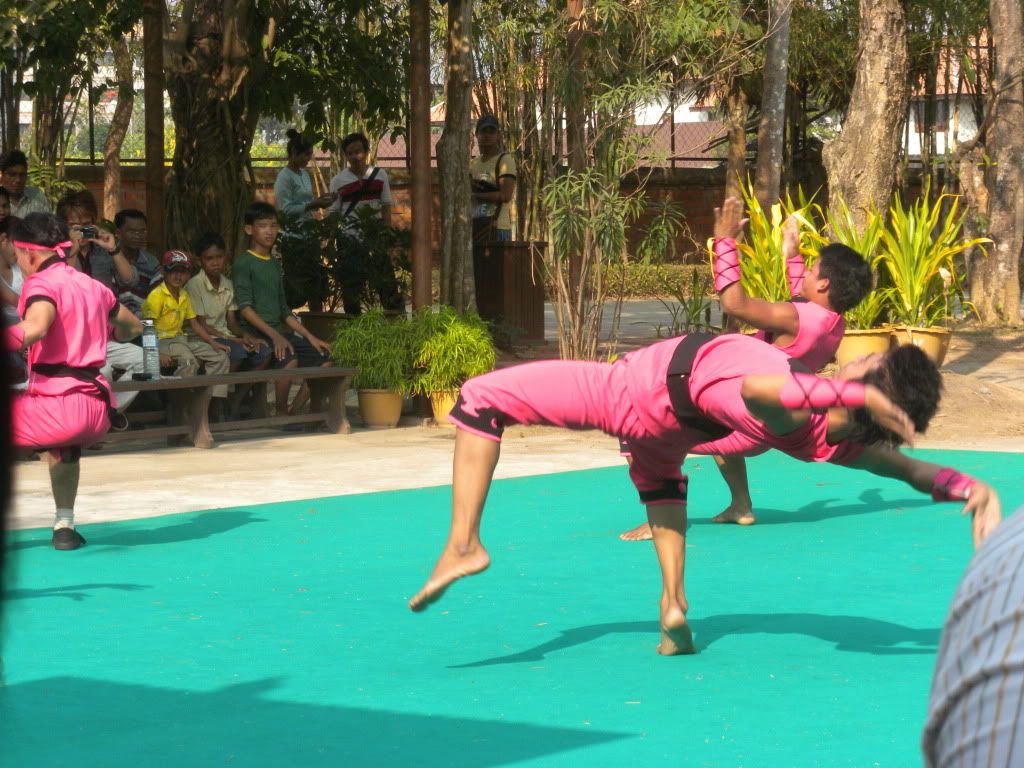
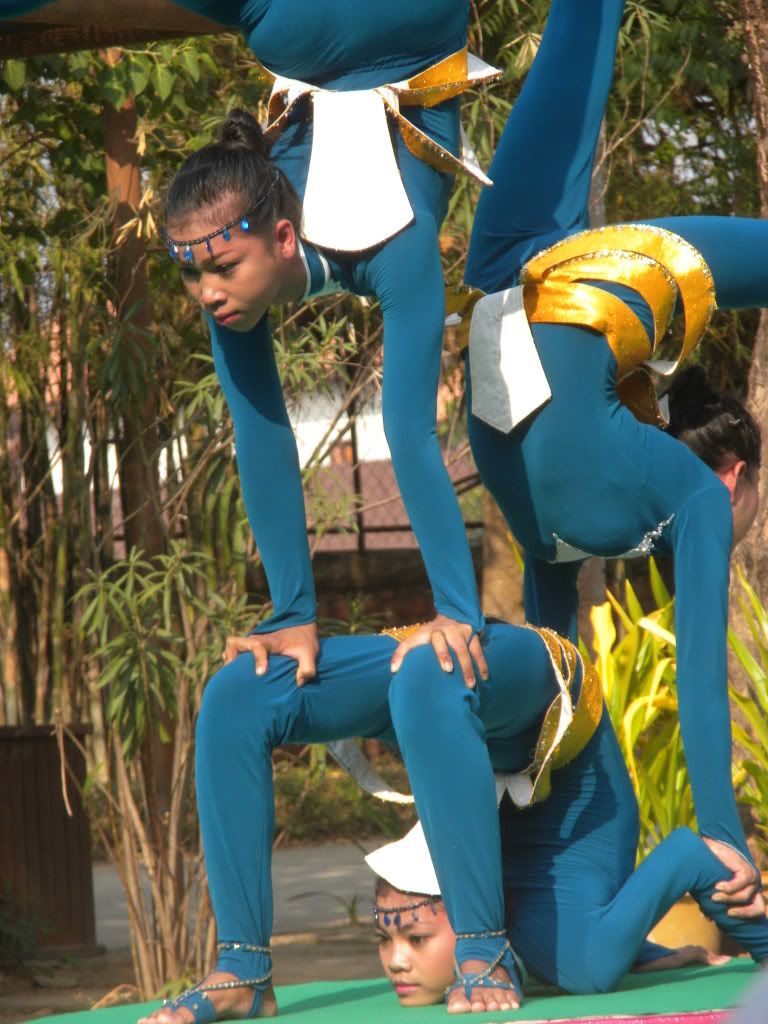
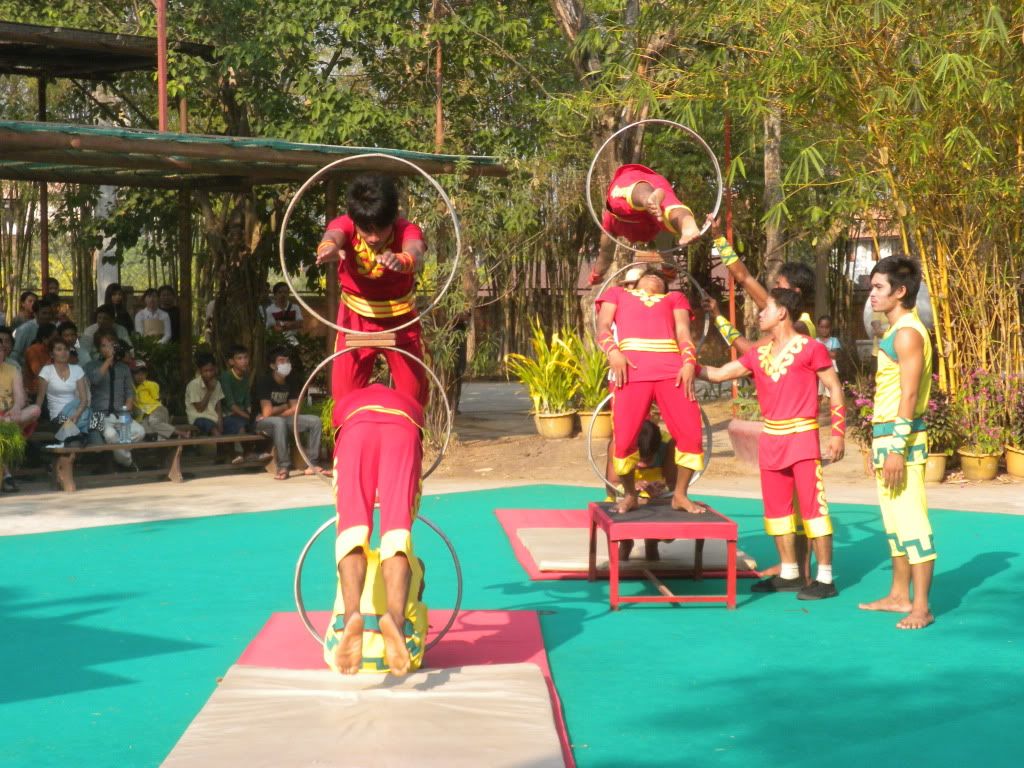
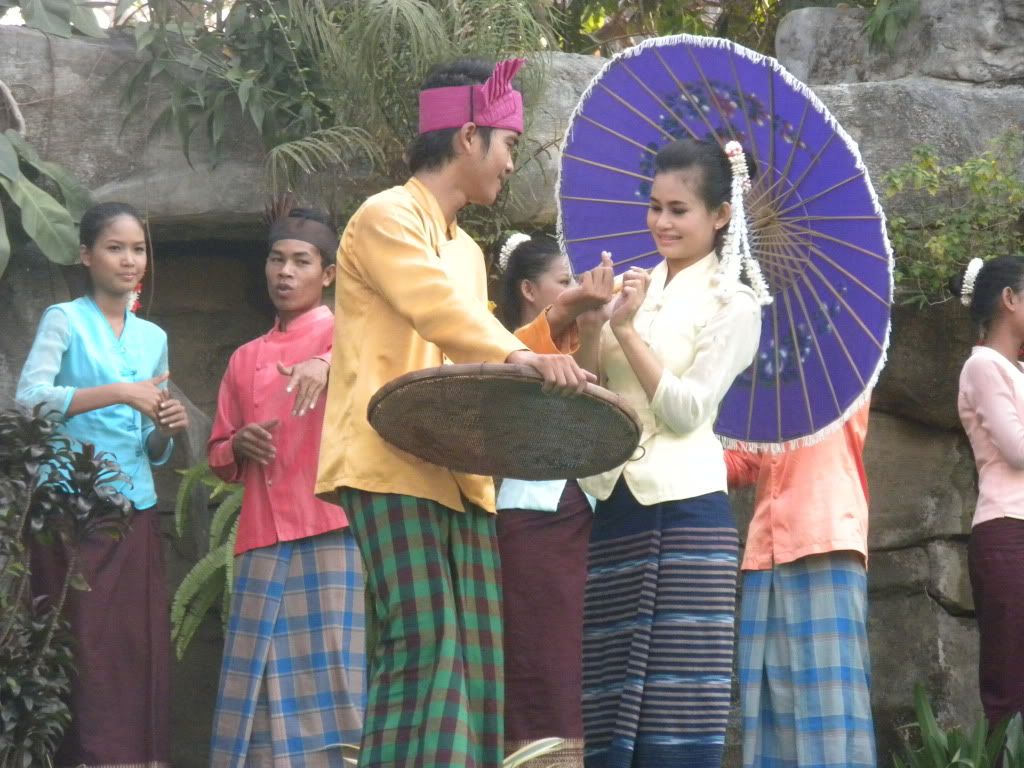
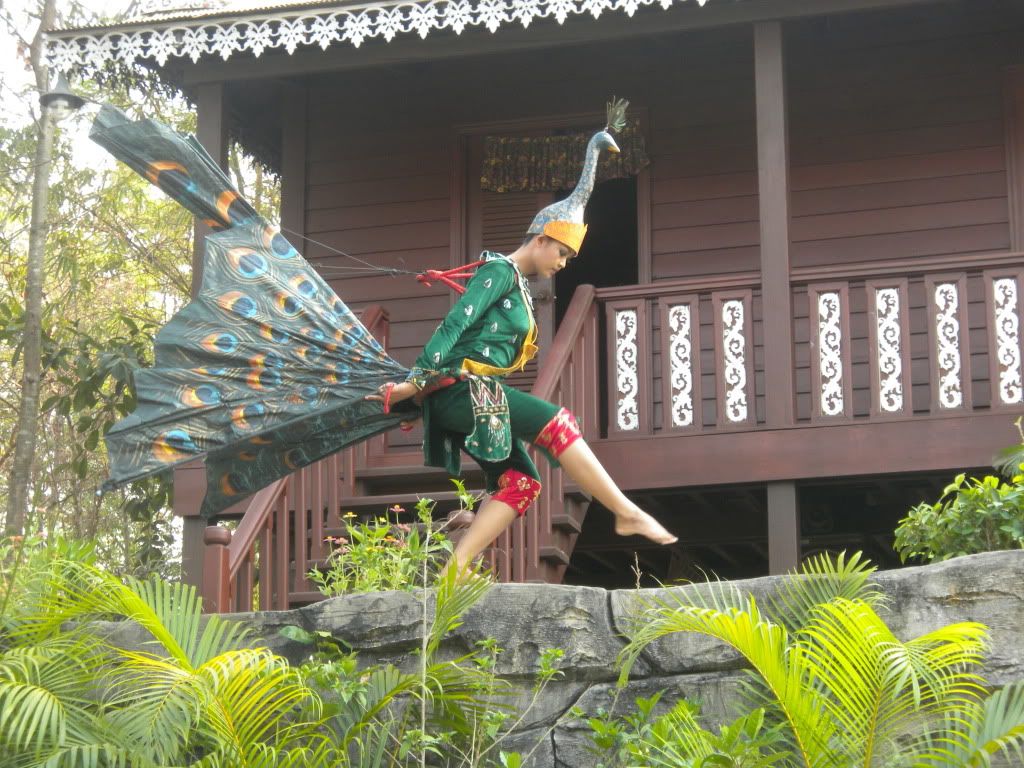
One of the most interesting performances seemed more like a comedic act than a dance. It was called ‘Choosing Fiance’ and was performed at the makeshift Kroeung Village. If you can only see one or two shows make sure this is one of them!! It told the story of three suitors coming for the daughter of a couple who was seeking a husband. Now to explain, the Kroeung people are hunters who build their daughters their own little ‘house’ when they are looking to get married. Travelers or locals who see this sign know they can try for her hand.
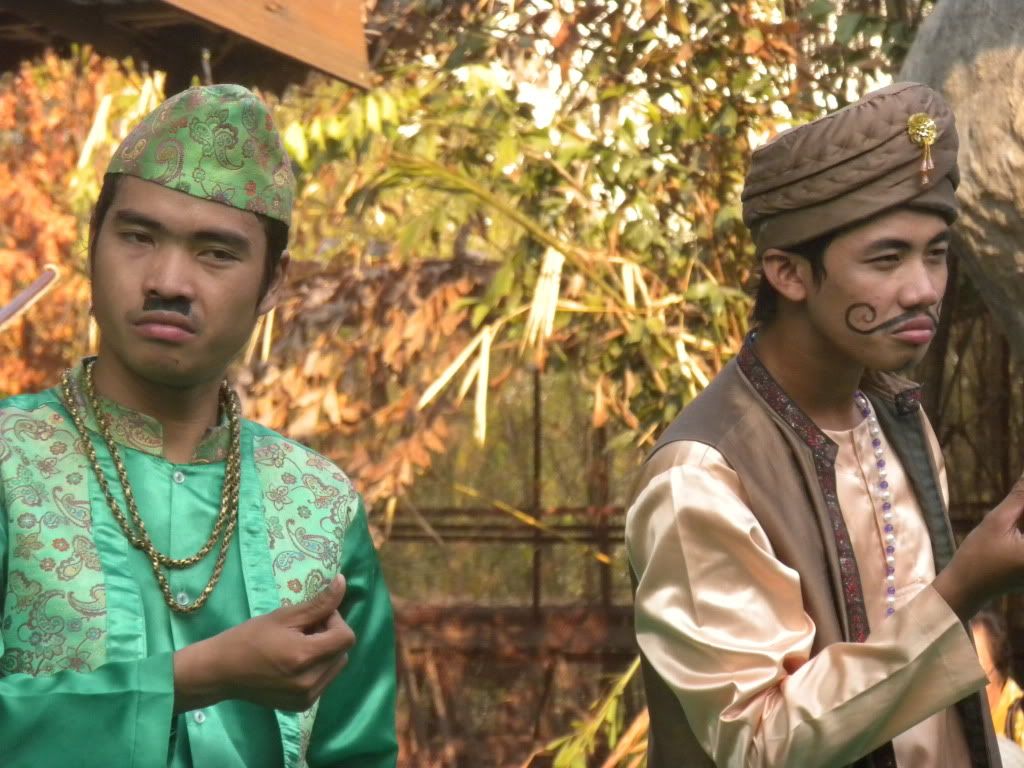
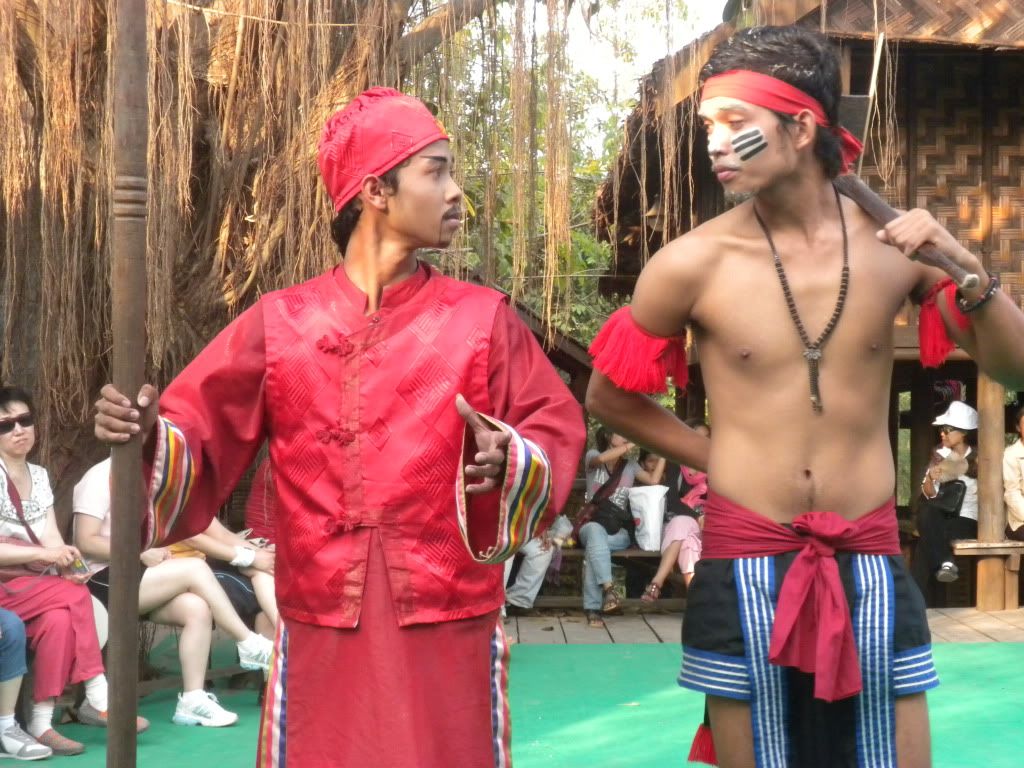
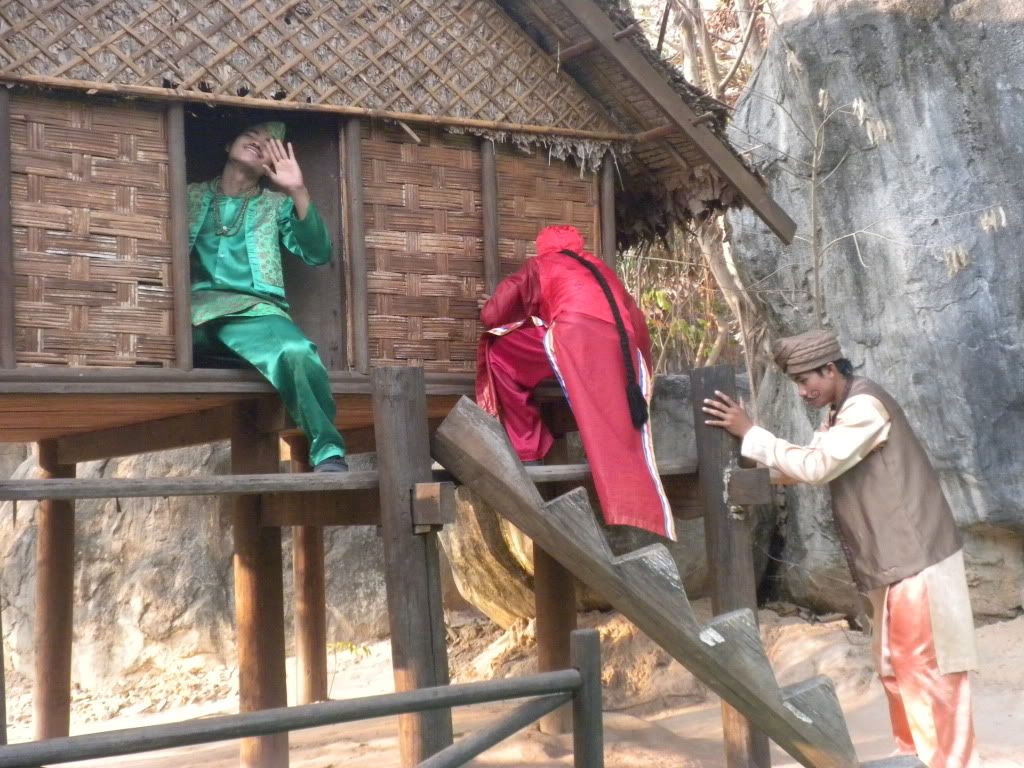
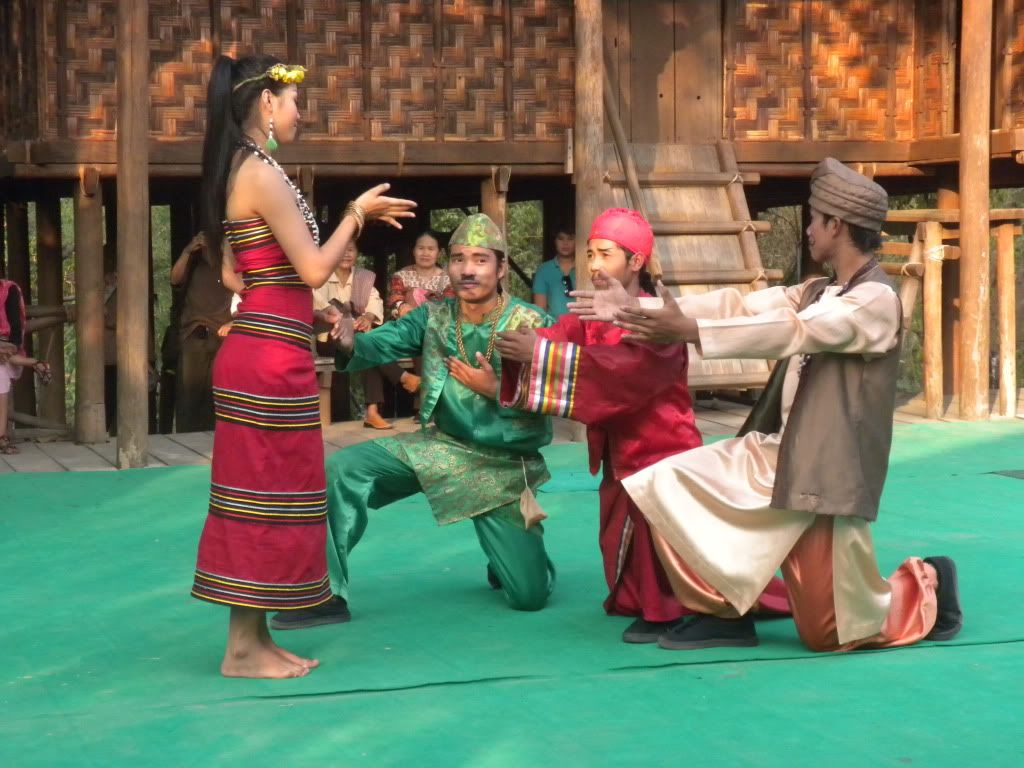
In the show a distinctively Muslim man, Indian man, and Chinese man show up. They all try to win her affection, even sneaking to her in the middle of the night to try and woo her. Their facial expressions were hilarious and the fake facial hair just classic. In the end, she ends up selecting a white man from the audience to marry over all the others. I noticed that the majority of the viewers around me in the stands were actually locals… who must have a great sense of humor because they loved the performance!
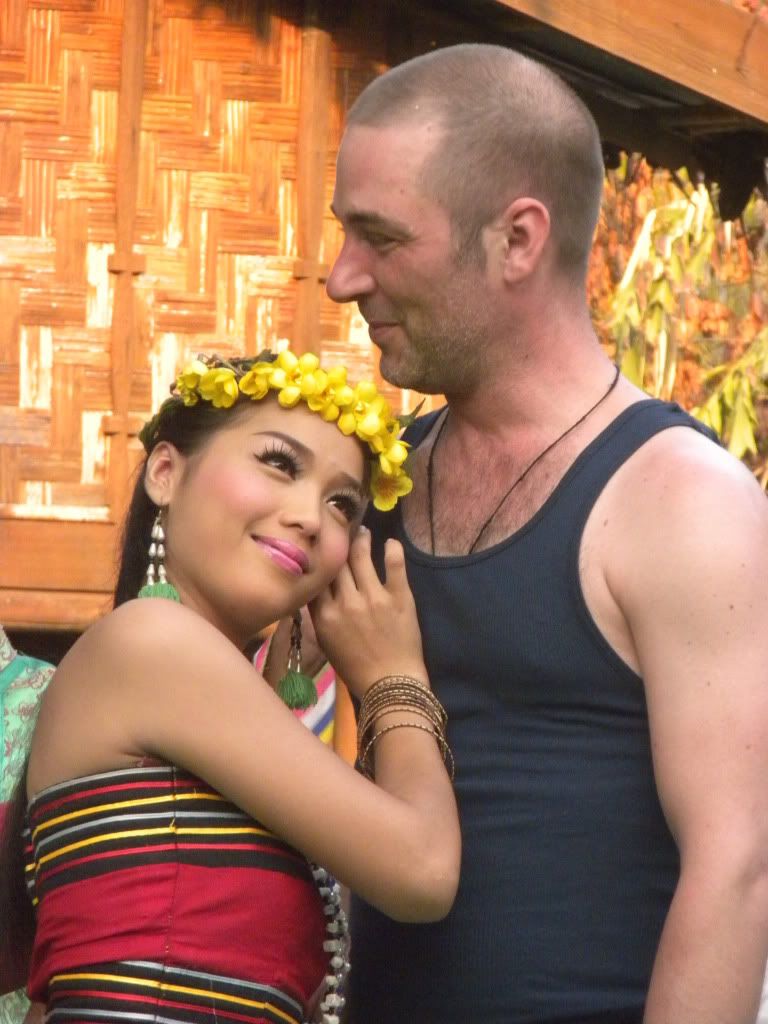

Next my guide led my through the ‘Judgment Tunnel & Ghost House’ which was basically a mini haunted house which started by showing us a wax figure of Yama, the Hindu God of Death/Judgment. As we made our way further the figures began to resemble those from Angkor’s bas-relief depiction of hell: bodies being torn apart, punishment according to the crime during life. One woman had two large sharp-tooth slugs biting her nipples for eternity because she had breast-fed during a Buddhist ceremony! I couldn’t take any pictures at this point though because the camera had died. So for these next examples you’ll have to settle for the pictures from their website:
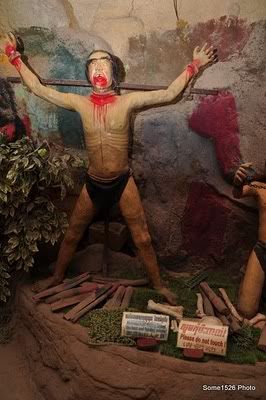
The Khantremming Dancing show in the Khmer Village used live animals which, of course as animals are unpredictable, left a trail of… well, you know… across the stage. Twice! Anyways, this show involved many people trying to lift a magical ‘bow and arrow’ set from its sacred place. However, only a strong foreign man chosen from the audience could do it! (It was basically a ‘Sword in the Stone’ type of deal.) Lots of traditional Khmer dancing was involved, and the show was probably one of the more elaborate ones to watch.
We were nearing the end of the dances by now and the second to last show was another minority dance. This was the Rice Praying ceremony of the Phnorng people, who are an aboriginal Cambodian ethnic group. Here is the website’s explanation (I cleaned up the grammar) of the Phnorng people and their ceremony:
“Phnorng people are led by a Water & Fire Master. He is only the person who can keep and take care of the Preah Khan (sword) and Rompoat (whip) which granted by ancient Khmer king. The Water & Fire Master was full of power and had own servants, but became weaker until he had no servants. Nowadays, no one wants to be master, but in order to take care king's sword and whip, the tribal group still have to select and install one person to be the Water and Fire Master.”
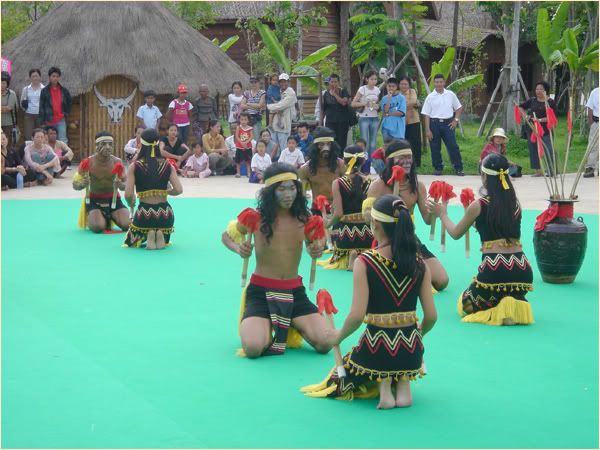
The final show was the Fri-Sun only performance of ‘The Great King Jayavarman VII’ at the Big Theater. This show was the story we were now quite familiar with, of Jayavarman fighting and defeating the Cham in battle and then constructing Angkor Wat with bas-reliefs detailing the victory. There was a grand re-enactment of the fight, which I was quite impressed with, although the dialogue was all in Khmer so you just had to kinda go with it.
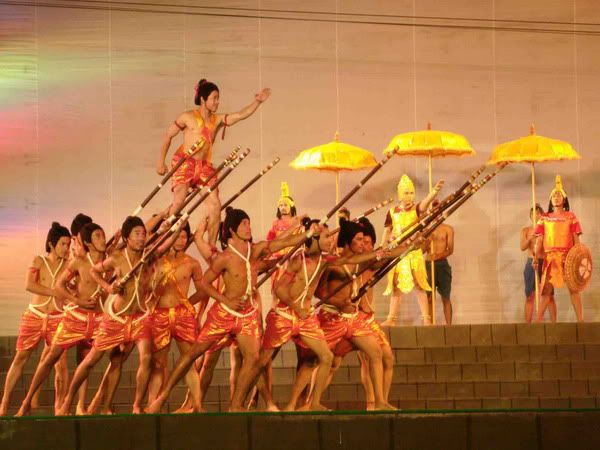
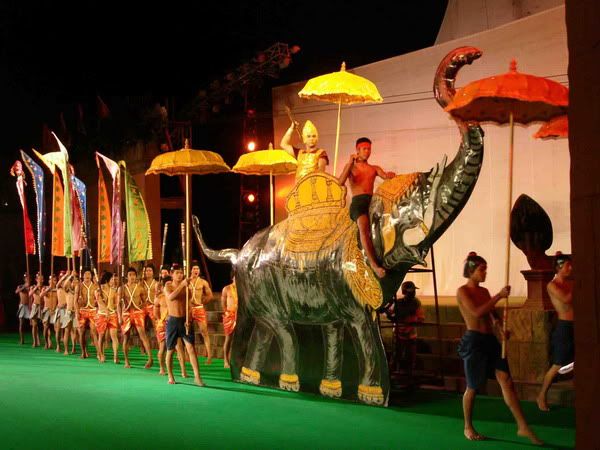
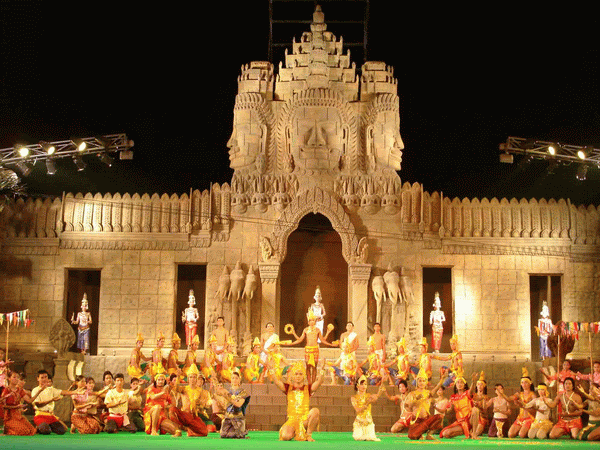
And the day of shows was complete! I caught a ride back home with a nice couple who didn’t want me to have to wait for a tuk-tuk, and had the driver drop me off at The Pizza Company so I could pick up some dinner to bring back with me. When I arrived I found that Henk had all the bags packed for our departure the next morning to Phnom Penh! We headed to bed early knowing we would have to be up for our long bus ride…
Once we made it on the bus, we sat back and tried to relax. We watched the movie ‘August Rush,’ about a young musical protégé, which I was delighted to see Henk really liked. Then I read some short stories from my new book ‘Australian Tragic’ to try and make the time go by faster. At one point we ended up being locked on the bus along with a handful of other people, having been left by our driver, but we survived the ride and headed towards the Bright Lotus I which was recommended by the Lonely Planet for its great location.
However, right near that guesthouse we found an even better one with free Wi-Fi called Aka Guesthouse. Henk ran to get me a snack from next door while we rested up for a few hours. That evening we walked along the river and explored the night market… also finding out exactly how crazy the traffic is and how covered in trash the streets are in the process! Yuck. The market was nothing too unique. It had interesting and cheap clothing as well as an amateur performance stage where dancers and singers were showing their skills. Since we didn’t find any suitable restaurants on the way back we grabbed dinner from the same place Henk had gotten my bagel earlier and went upstairs to watch ‘Transformers.’
Thursday, April 1, 2010
Wanna Be On Top... Of Bayon?
The third level of Angkor Wat is reached by climbing a steep staircase, ending up on a raised part of said level. The raised walkway goes around the sides and through the middle, splitting up and going to the sides. The center had an old Buddha statue, which was still actively worshiped. Several elderly ladies were having their photos taken with other statues around. I walked around and got a decent look at four of the five main towers of Angkor Wat. Obviously I could not see the main one; it was somewhere above my head. As I walked around on the walkway I also got a decent look of the surroundings. I can imagine how impressive the city must have looked in its heydays.
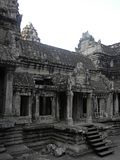
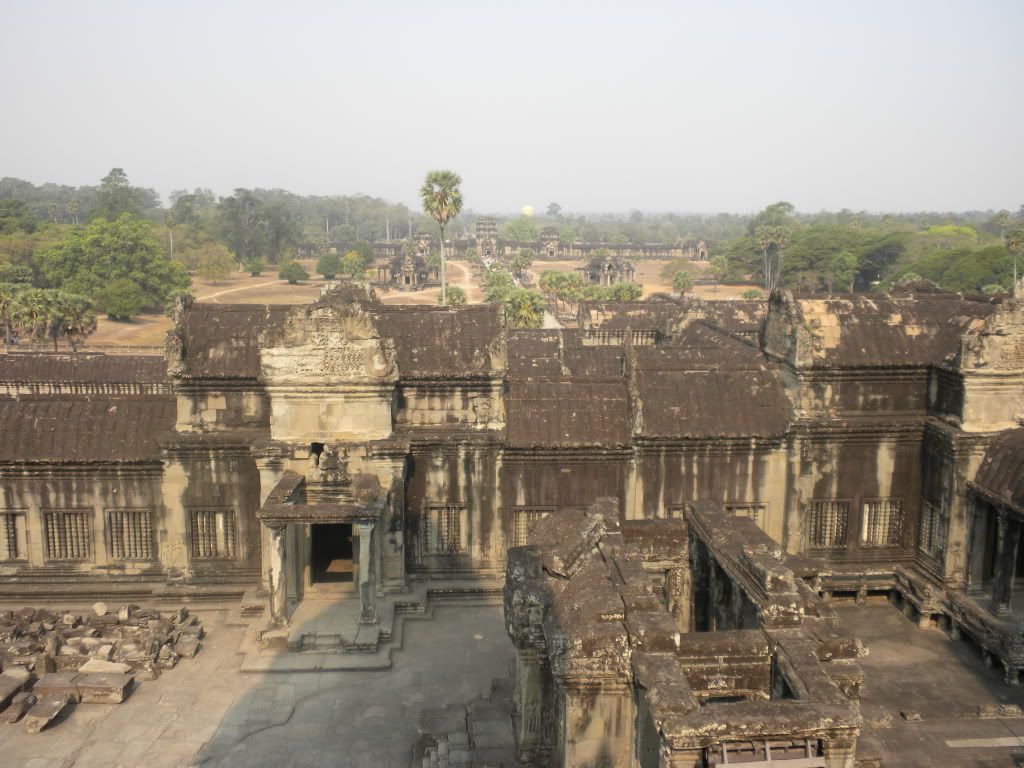
I descended the staircase to go back to Francesca. I showed her the pictures I had taken and we were on our way again. Our next stop was, not surprisingly, the Bayon again. We both wanted some more time with the giant faces. But before we headed up to the visages Francesca and I read a little display on the research done on the faces and the Bayon itself. We read about the construction of the faces, which were worked on by two artisans at the same time, each doing one side of the work of art. It was the only reason they were done within a few months. We also learned the faces represented three different, but similar expressions.
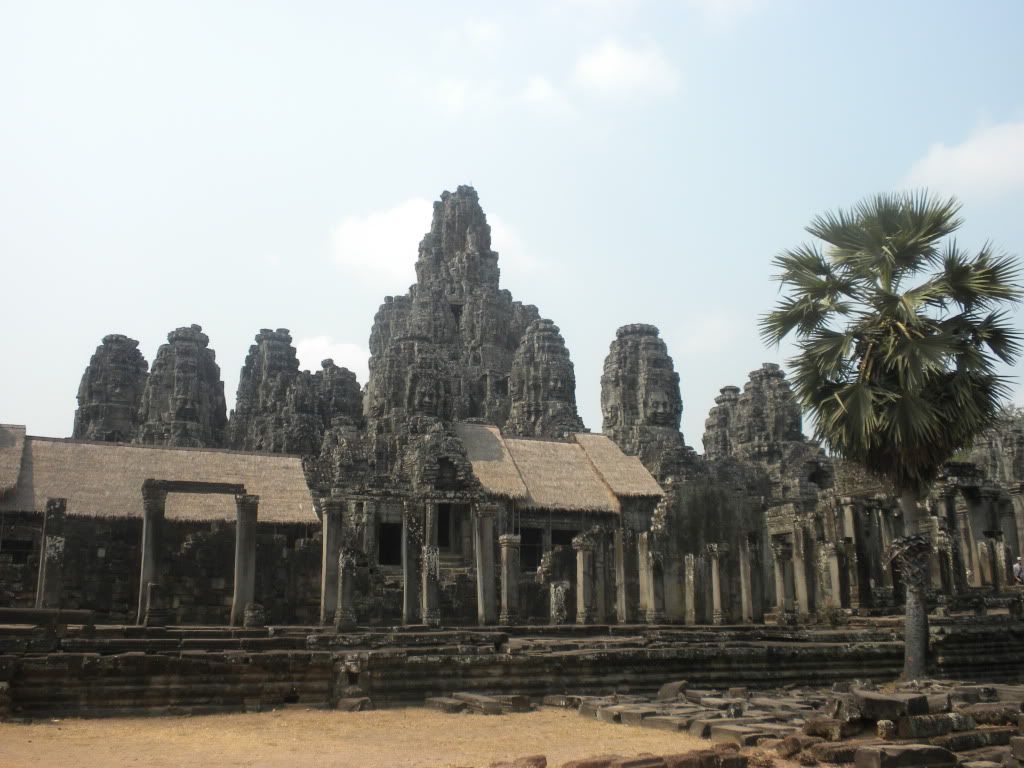
Another interesting thing we had learned was that the Kings after Jayavarman VII had switched the state religion back from Mahayana Buddhism to Hinduism. They, along with Siamese invaders, destroyed all the Buddhist statues and carvings at all the temples. Without preserving the Buddhas they just chiseled them away. We had been looking carefully and actually found a few in a decent state! New knowledge absorbed we headed up the small staircase and went straight for our photo shoot. Whilst we were working on the poses I spotted a monk posing as well. Cool picture alert! Next, we tried to get a photo of us looking at each other with a stone smile behind us. Four different people didn’t get the simple concept, leaving us with a decent picture that could have been better. Anyway, here’s the result of the whole shoot!

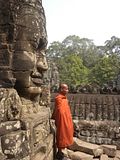
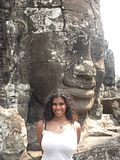
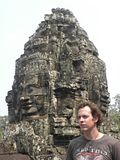
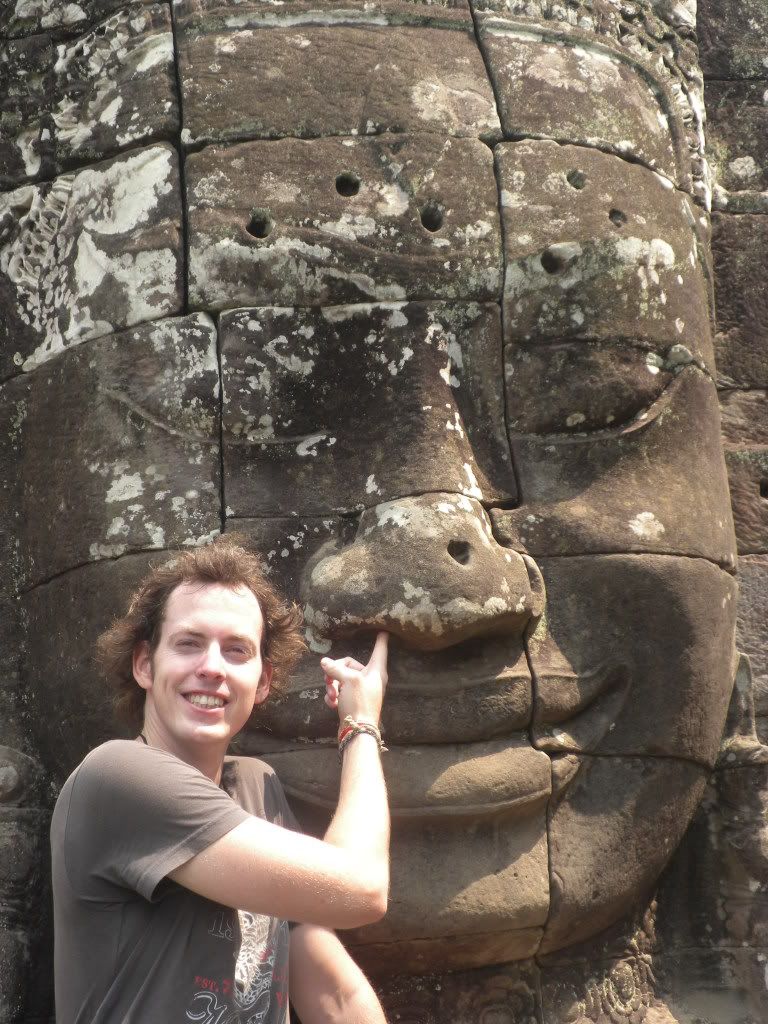
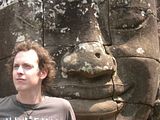
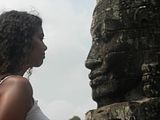
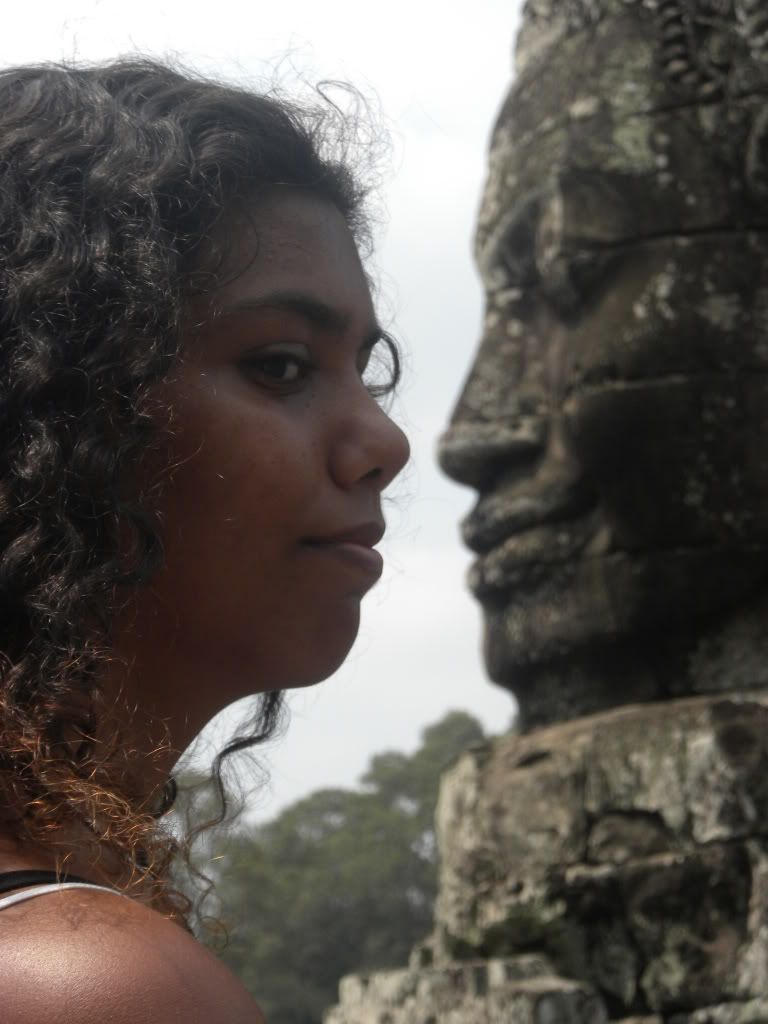
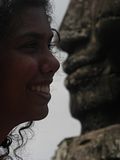

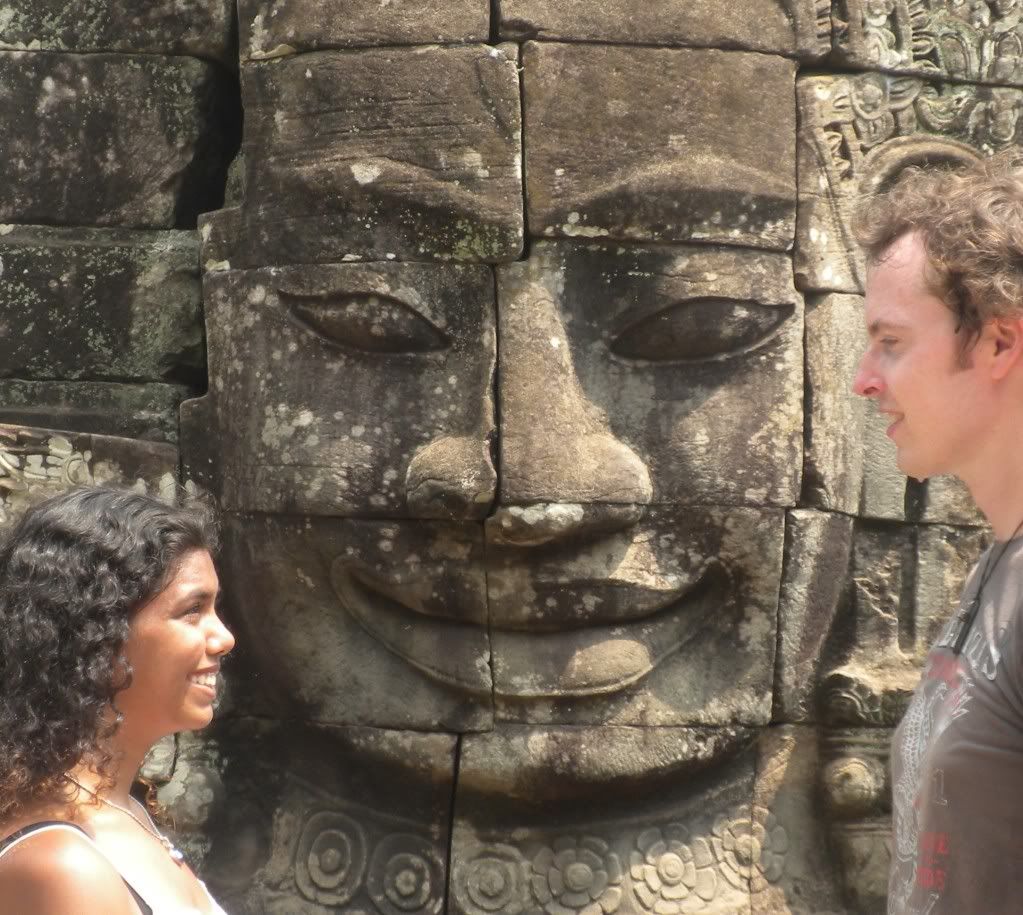
On day one Francesca and I had missed Baphuon, even though it was part of the small circuit of that day. We asked our new tuk-tuk driver to take us there to get a chance to explore it. Wiki tells us: “Built in the mid-11th century, it is a three-tiered temple mountain built as the state temple of Udayadityavarman II dedicated to the Hindu God Shiva. In the late 15th century, the Baphuon was converted to a Buddhist temple. A 9 meter tall by 70 meter long statue of a reclining Buddha was built on the west side's second level, which probably required the demolition of the 8 meter tower above, thus explaining its current absence.”
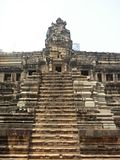
Baphuon’s claim to fame is not in any of its architecture, however. Most of the temple was in a pretty poor state when it was rediscovered. The French had tried to restore Baphuon since the 1940s, carefully taking apart the whole thing, laying the stones out around the base and writing out every step of the way. When the Khmer Rouge came to power the French were forced to leave head over heels. When they came back they found their plans were gone… Now they were left with the world’s largest jigsaw puzzle. Only in 1995, after many years of research, did they start rebuilding. Even on the day of our visit rebuilding was still going on and our visit restricted. We actually couldn’t see much of the reclining Buddha at the back.
As I wrote this I realized Francesca accidentally already talked about Baphuon. I moved it from her post on the previous day to this one here so you can also read her account of our visit to Baphuon:

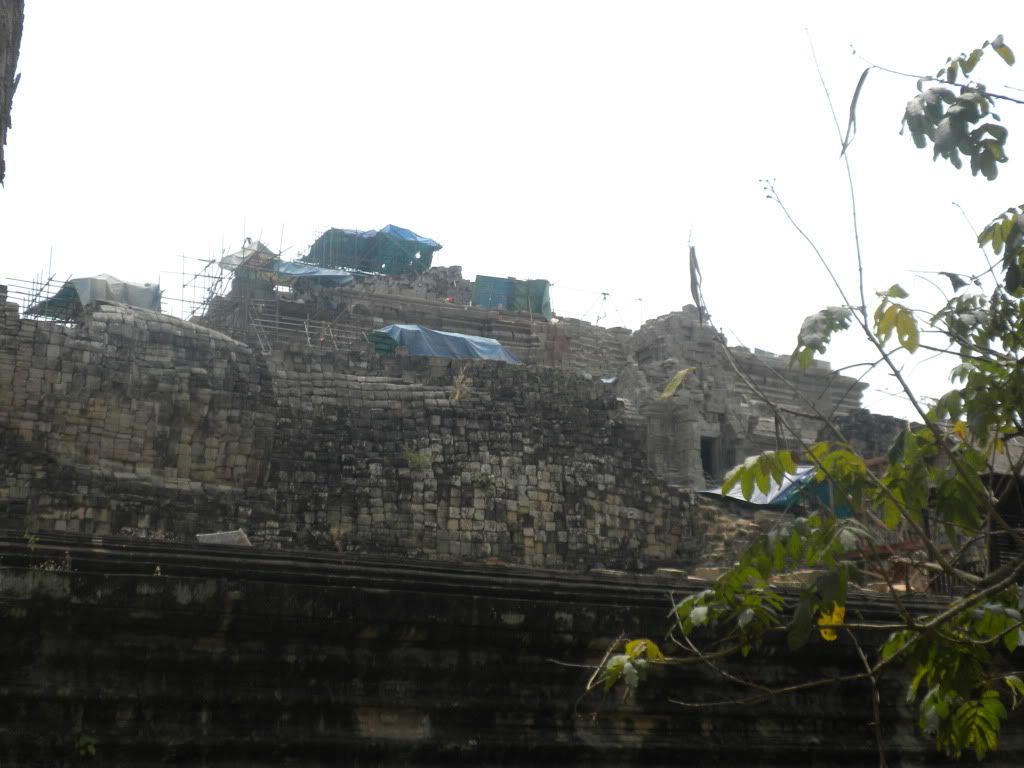
“We had first passed by Baphuon on our first day in Angkor Thom, but we didn’t realize the complex couldn’t be seen from the front. (It was our guide’s fault for not wanting to walk us in. Be careful your guide doesn’t try to ‘cheat’ you out of seeing what is on the itinerary! Keep track yourself. Guides in South-East Asia have attempted this ALL THE TIME with us so we should have known better.) Anyways, once we walked down the bridge towards the temple we saw just how huge Baphuon was. And even though it was currently under major restoration and you couldn’t go inside, it was worth it just to walk around the building and marvel at it. At the back was supposed to be a large reclining Buddha etched into the stone, but again, it was being reconstructed. I later went to the Cultural Village and saw what it should look like so I’ll post the picture I took of the model here.”
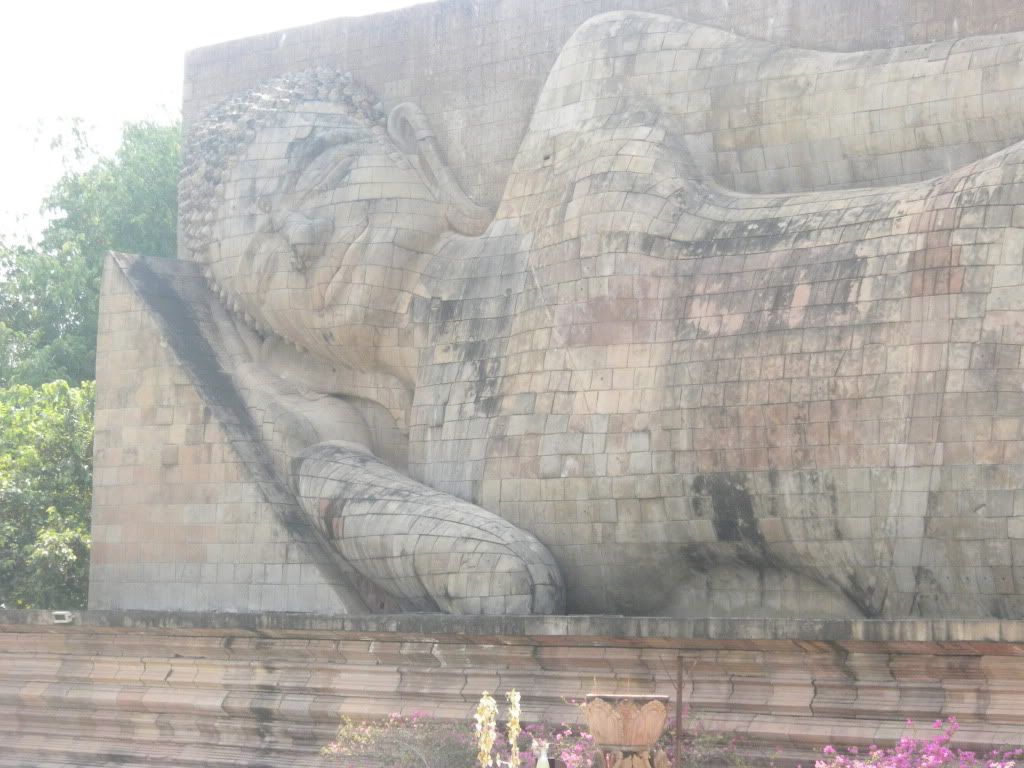
Next up were the two remaining temples of the grand circuit. Our guidebook told us Preah Khan was built on the site of Jayavarman VII's victory over the invading Chams in 1191. Like Ta Prohm, Preah Khan has been left largely untouched, letting the strangler figs grow in and over the temple. Francesca and I walked over the causeway and found another ‘Churning’ before hitting the main walls. A huge Garuda made for a good photo opportunity, as both of us posed with it, copying its outstretched arms. We headed inside and marveled at the size of the complex. We learned that at one point Preah Kean had 100,000 people scurrying about its premises. I actually felt quite humbled by the large stacks of rocks that were all over the place. It gave the place an eerie feel.
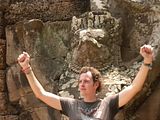

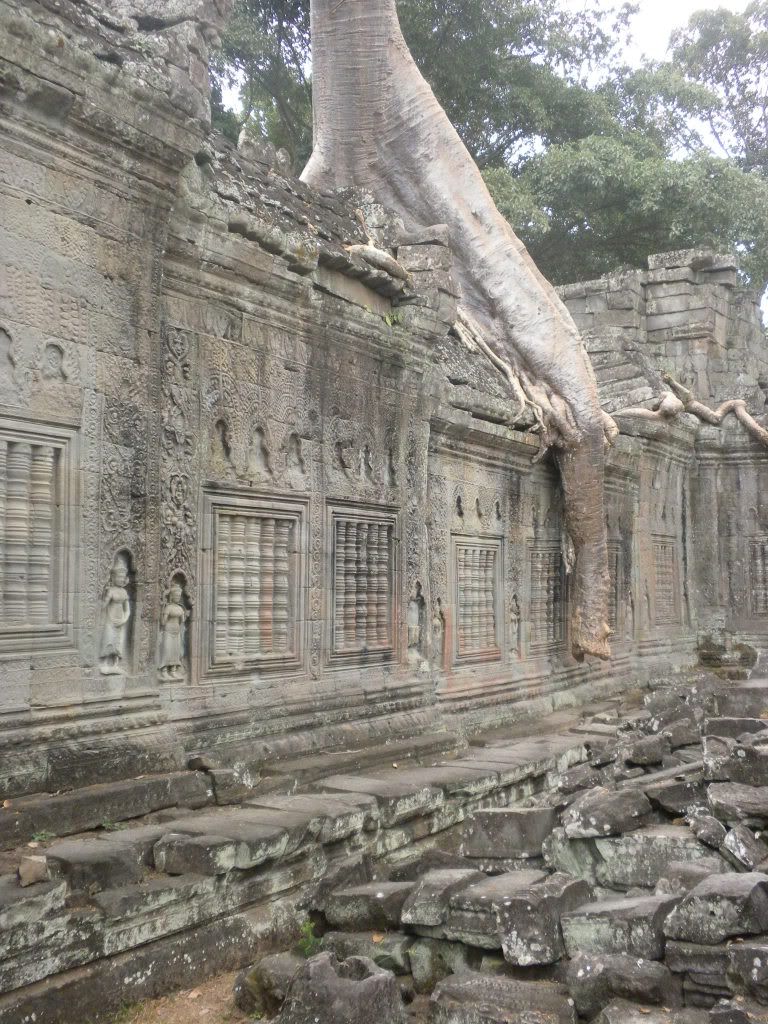
Neak Pean was the last grand circuit temple on our list. Technically, Neak Pean isn’t even a temple; it’s an artificial island with a Buddhist temple on a circular stupa-like fountain in the middle. The water that once might have filled the basin surrounding Neak Pean had dried up during the dry season, making it look far less impressive than it could have been. We saw restoration and renovation were going on, leaving the few carvings covered in protective wooden sleeves. We decided to turn around and headed back to tuk-tuk man.
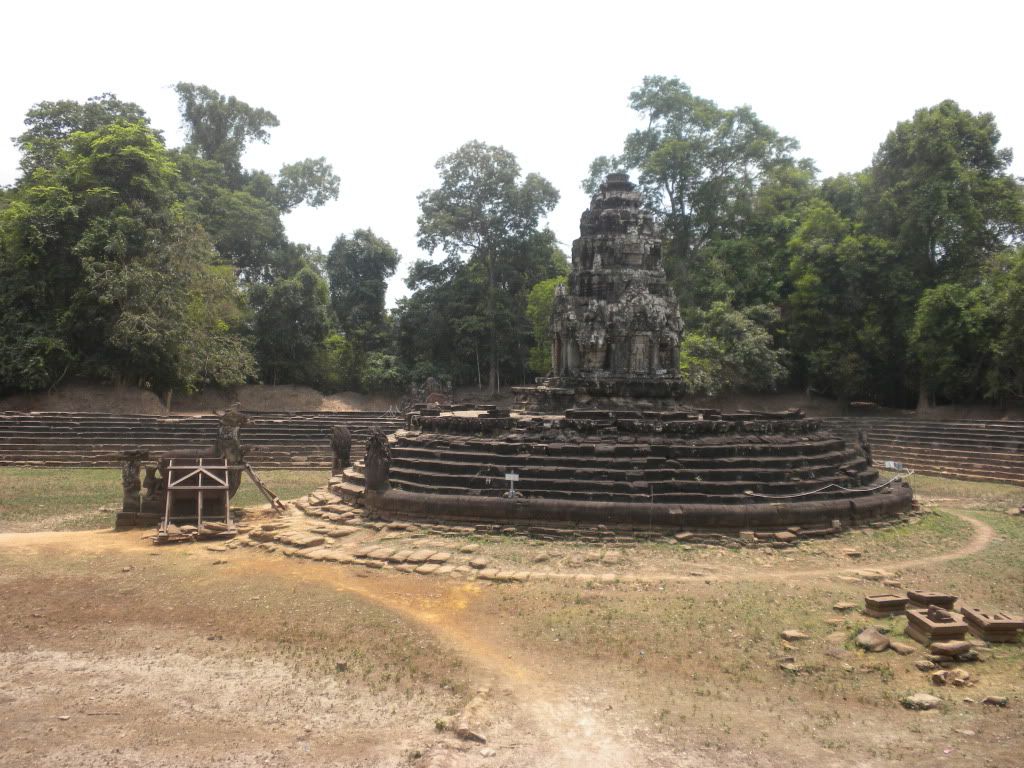
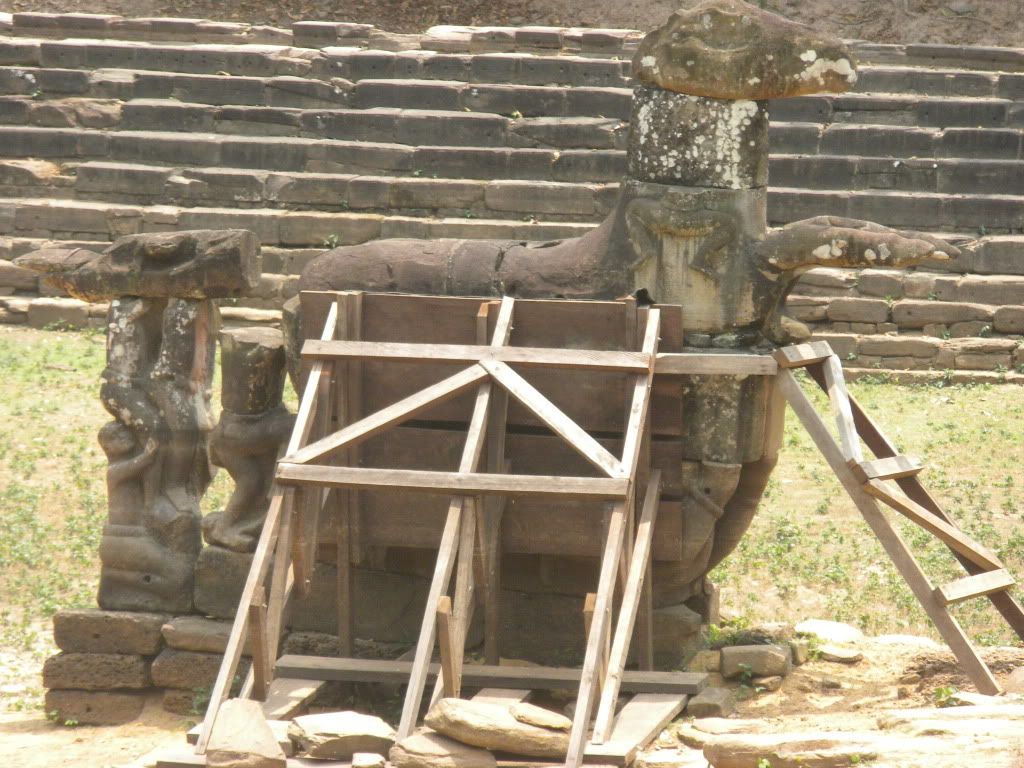
Visiting so many different temples with similar names in such a short span of time makes it hard to remember everything you’ve seen. I thought that we had also missed Banteay Kdei on the first day of our trip, but when we showed up there we soon realized we had already seen it. Luckily there was one last place we had missed right across the street from Banteay Kdei: Srah Srang. Srah Srang was also not a temple. It was a water reservoir, in all likelihood built for either religious or agricultural purposes. The most notable feature of this so-called ‘baray’ is a sort of platform overlooking the reservoir. Statues of stately Nagas and Lions guard the water, as they’ve done for centuries.
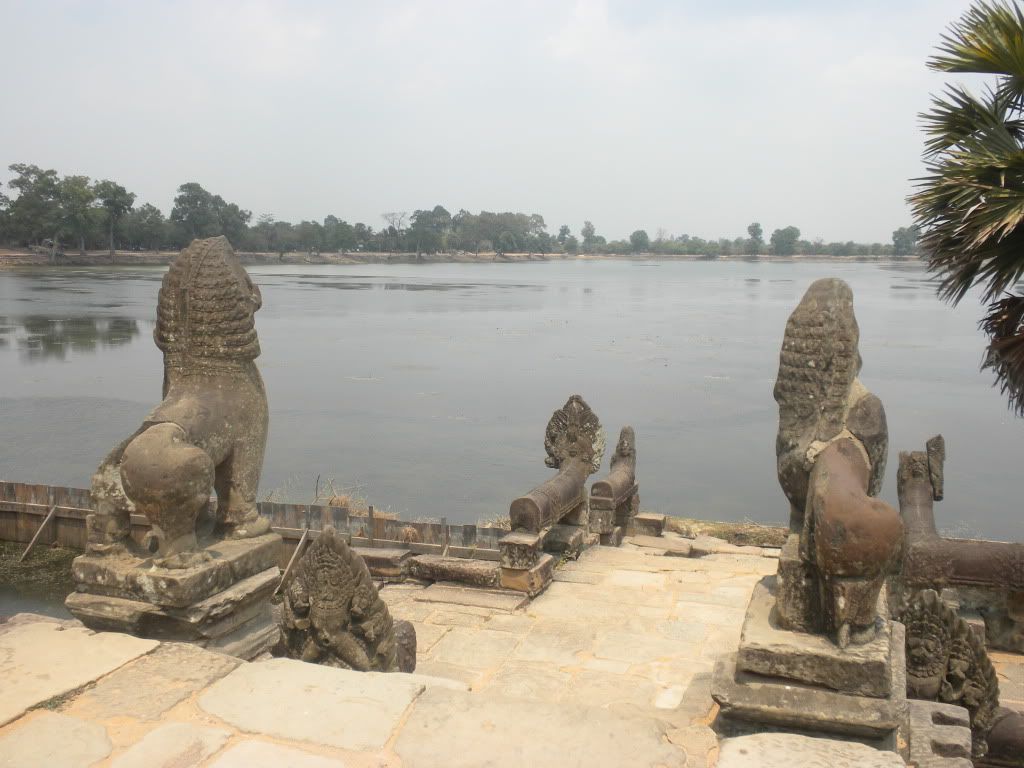
This concluded our epic three-day adventure at Angkor, filling us with many memories and stories never to be forgotten. We asked our driver to take us to the city center, where an Indian lunch at Maharajah tasted extremely well after all the walking. Here’s Francesca scooping up some yellow rice, ready to devour her butter naan and butter chicken. I’ve yet to start on my chicken saag. After lunch we returned to the shadow and watched some documentaries on chimpanzees. We thought we deserved the quiet time!
